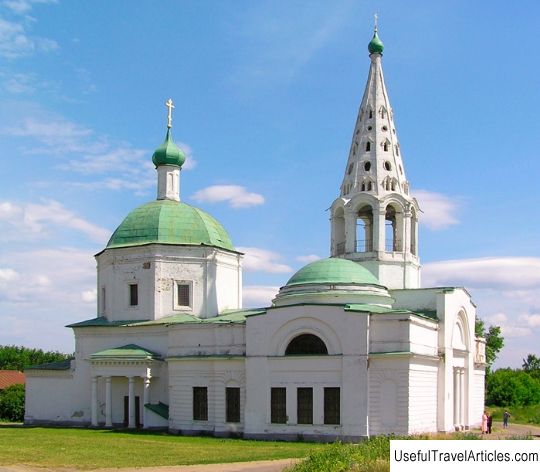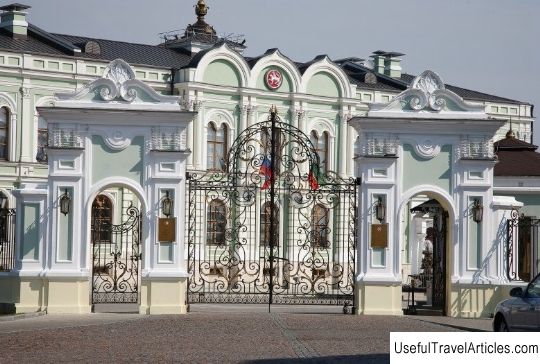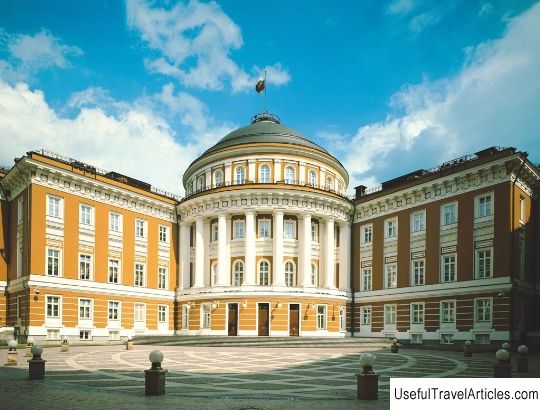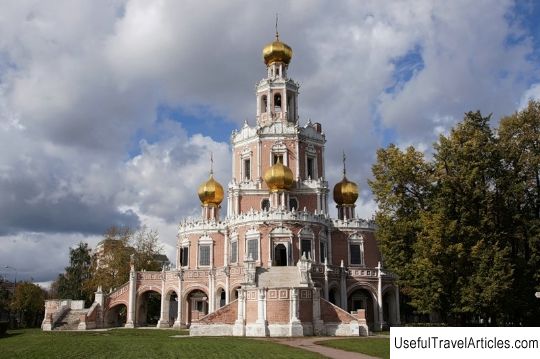Amusing palace and the Church of Praise of the Most Holy Theotokos in the Kremlin description and photos - Russia - Moscow: Moscow
Rating: 7,9/10 (3544 votes) 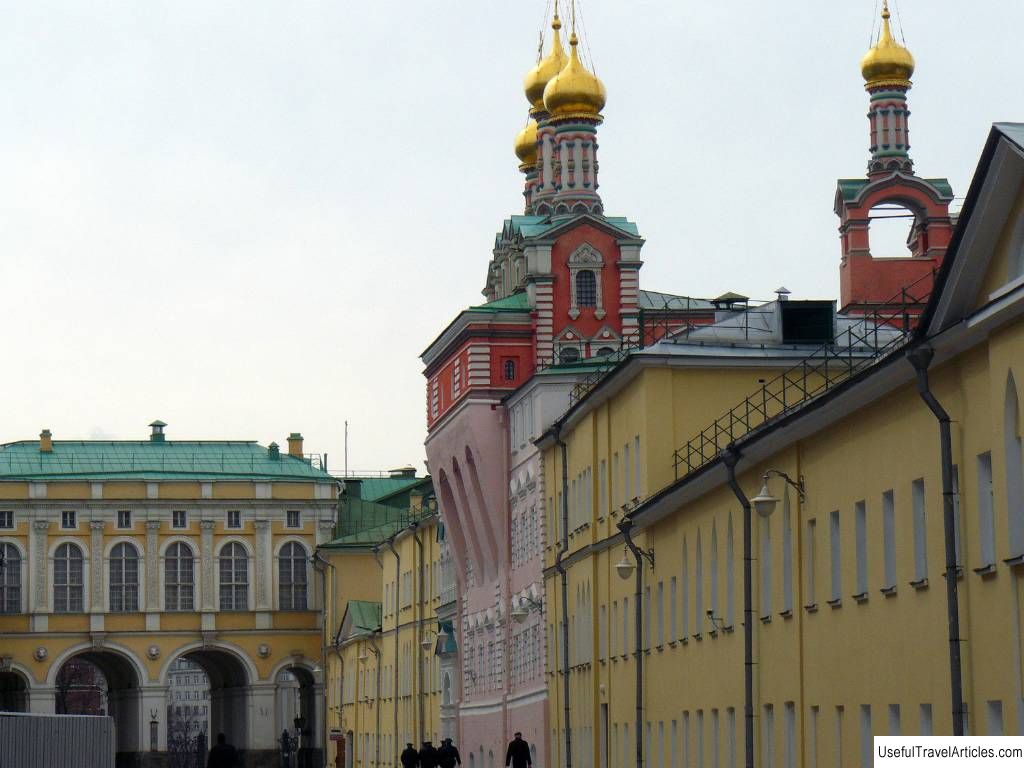
Amusing palace and church of Praise of the Most Holy Theotokos in the Kremlin description and photos - Russia - Moscow: Moscow. Detailed information about the attraction. Description, photos and a map showing the nearest significant objects. Photo and descriptionOn Palace Street of the Moscow Kremlin, running parallel to its western wall, among other buildings stand out the former living chambers of the boyar Miloslavsky, later called the Amusement Palace. The building is included in the list of objects of cultural heritage of the peoples of the Russian Federation and is the only surviving boyar mansion in the Moscow Kremlin. History of the construction of the Amusement PalaceBoyarin Ilya Danilovich Miloslavsky came from a not too noble family. His father was the governor of Kursk, and Ilya Danilovich himself went through the trade and diplomatic section: he negotiated with Sultan Ibrahim I in Istanbul, and then paved the way for fruitful cooperation between the Russians and the Dutch. However, real luck came to Miloslavsky in 1648, when the Tsar married one of his four daughters. Aleksey Mikhailovich was still young, and Maria Miloslavska I became his first wife. A few days later, the second daughter of Ilya Miloslavsky made a profitable game. Anna was married to a boyar B. I. Morozov , known as the educator of the tsar and who was one of the largest landowners of his time. Thus, the Miloslavsky family rose up, but did not find good fame among the people. The family was considered money-grubbing and lovers of bribes, and the sovereign treated his father-in-law without due respect. The desire to get rich quick led to the fact that an uprising, called the Salt Riot , broke out against the Miloslavskys and other boyars. Miloslavsky's relations with the tsar and the people did not prevent the boyar from rebuilding the chambers, which were later called Amusement Palace . For the estate, they chose a narrow space between the western fortress wall of the Kremlin and the outbuildings of the residence of the sovereign himself. In the center of a small plot, residential mansions were placed, from the south there was a front yard, and from the north - farm buildings. In the middle of the chambers, an archway was arranged, through which one could get from the utility yard to the front yard and back. In 1651, the construction of the Miloslavsky chambers was completed. The boyar didn't have to enjoy the new mansions for too long. After 18 years, he went to another world, and the building went to the treasury due to the boyar's absence of male heirs. The new royal estate was connected by transitions with the sovereign's residence, and members of the ruling family now began to live in the former mansions of Miloslavsky. For funThe first theatrical performances in Russia began to arrange in 1672. The venue for the performances was the former chambers of Miloslavsky, which received a new name at that time. Tsar Alexei Mikhailovich was pleased with the amusing palace. The sovereign liked the new entertainment, but each time after the performance, he carefully prayed for the forgiveness of sin and even washed it off in the bathhouse. After the death of his parent, the new king Fyodor Alekseevich additionally decorated the Amusement Palace. It has equipped special rooms for theater actors. At the performances, women of the royal family began to openly appear among the audience, and even boyar daughters shone among the participants in theatrical performances. Despite his tender age, the fifteen-year-old sovereign did not forget about the spiritual. The tsar ordered to build a house church in the upper tier of the tower. The church was consecrated in honor of Praise of Our Lady , and its chapels - in honor of Mary of Egypt and St. Alexis the man of God. Architectural features of the Amusement Palace The former chambers of the boyar Miloslavsky became one of the first stone residential buildings in Moscow. Erected after the Terem Palace, the mansions served as a model for the further construction of similar residential buildings: - The facades of the Amusing Palace are floor by floor and decorated with carved decor made of white stone. - The living quarters of the chambers are located according to the enfilade type , as well as Terem Palace. A similar innovation subsequently took root and most of the stone residential buildings in Moscow at the end of the 17th - beginning of the 18th centuries were designed according to the enfilade principle. - The brownie Church of the Praise of the Virgin was inscribed in the volume of the palace. The location of the church looks absolutely canonical - the architects managed to avoid the location of the altar above the living quarters. The temple rises above the eastern facade, and the altar space turned out to be carried out on mashikul-brackets, which protrude at the level of the upper tier of the building. Above the western facade is the church porch, formed by a flat roof. The daughter of Tsar Alexei Mikhailovich Princess Sophia played an important role in the reconstruction of the Amusement Palace. Having moved to live in the former boyar chambers with her sisters, Sophia turned them into a real palace and personally supervised all the decoration and repair work. Lion's GateOn the south side of the courtyard of the Amusing Palace The Lion Gate, also called Preobrazhensky portal . The history of the monument has hardly preserved any documentary evidence describing its construction and purpose. It is only known that the Lion Gate appeared in the Moscow Kremlin in the middle of the 17th century. white stone was used for their construction, the blocks of which were covered with carved ornament. The pattern depicted the Garden of Eden with its inhabitants, the plant ornaments of which were closely intertwined with state symbols. According to historians, the ornaments were originally polychrome, but later they were repeatedly painted over with whitewash. The gate got its main name thanks to lion sculptures , which, as weights, served as a support for small arches. Weights were on the list of decorative elements of Russian stone architecture and usually looked like overturned pyramids. Weights in the form of lions are a rare type of such architectural details. After the revolution, the director of the newly created museum in Kolomenskoye P. D. Baranovsky came up with an initiative to carefully measure the gate and photograph them. After the work done, the Lion Gate was dismantled and taken to the Kolomenskoye Museum . Currently, fragments of the portal are kept in Kolomenskoye in the Sytny Dvor room, and in the basement of the Front Gate of the estate you can see a reconstruction of the Lion Gate decor made of preserved carved blocks. From Peter I to our days Ascended the throne Peter I he did not recognize entertainment in the spirit of the Amusement Palace and placed the Police Order in the building of the former boyar choir. The guards of the law sat in the Amusement Palace until 1806, when they decided to rebuild the mansion for the needs of the commandant of Moscow: in the former chambers of Miloslavsky it was decided to place the office and living quarters of the capital's commandant. Construction work was headed by Ivan Yegotov , whose project provided for the change of the main facade from the west to the east. So they demanded general restructuring in the Moscow Kremlin, where Palace Street was re-formed. In order to give the building symmetry, the northern wing was erected, and pseudo-Gothic decorative elements appeared on the facade. Gothic was added to the interiors of the palace. The house church of the Praise of the Virgin was abolished by dismantling the domes and crosses. After the revolution of 1917 , many famous and important persons who served in the Bolshevik government and who sympathized with them lodged in the Amusement Palace. So in the late 1920s, you could see here Bronislava Markhlevskaya , who at that time was already the widow of the Polish revolutionary and fighter for workers' rights Julian Markhlevsky. In one of the rooms of the Amusement Palace in November 1932, Nadezhda Sergeevna Alliluyeva , Stalin's wife, was shot dead. The last restoration of the Amusement Palace was carried out in 2000-2004. The initiator was the service of the Moscow Kremlin Commandant's Office , which now lodges in the former boyar mansions. The restoration touched not only interiors. Work was organized to restore the facades of the Church of the Praise of the Virgin, which was abolished in the 18th century. As a result of the renovation measures, the restorers discovered a unique carving made on the white-stone window-sills of the main floor of the palace. Plots, made by an unknown master, are very atypical for Russian art of the 17th century. The stone cutter depicted many real and mythical plants and animals and scenes of knightly tournaments.     We also recommend reading Mansion of La Sebastiana (La Sebastiana) description and photos - Chile: Valparaiso Topic: Amusing palace and the Church of Praise of the Most Holy Theotokos in the Kremlin description and photos - Russia - Moscow: Moscow. |

